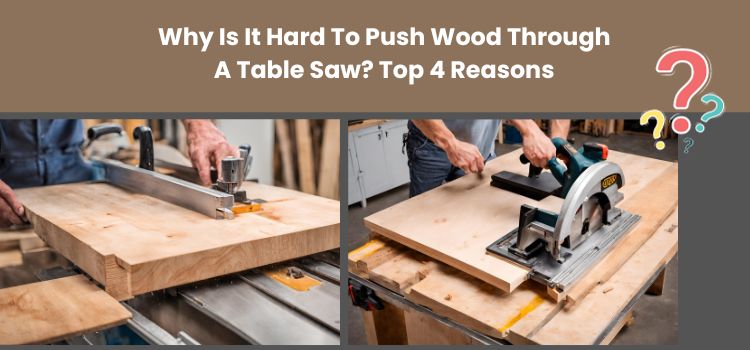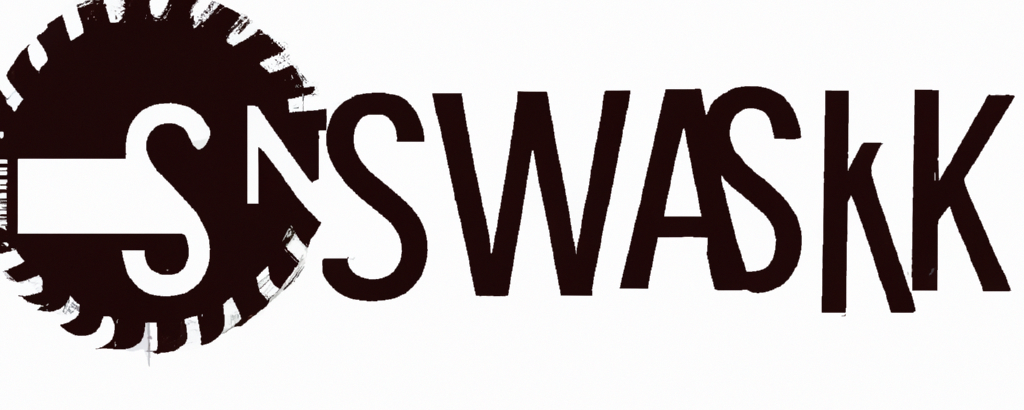Why Is It Hard To Push Wood Through A Table Saw? Top 4 Reasons

Table saws hold a crucial role in woodworking, offering precision and flexibility in various projects. However, the frustration of difficult wood feeding can disrupt your work and potentially pose safety hazards.
In this post, we delve into the causes behind wood binding and pushback while using a table saw, as well as practical solutions to ensure a smoother cutting experience.
Understanding Wood Binding and Pushback
Wood binding and pushback are prevalent challenges encountered by table saw operators. Binding transpires when the wood becomes trapped between the blade and the fence, leading to potential cut disruptions and even kickback.
On the contrary, pushback occurs when the wood resists the feeding force, causing uneven cuts and potentially hazardous situations.
Identifying the Root Causes
Several factors contribute to the occurrences of wood binding and pushback on table saws:
Blade Alignment:
A misaligned blade can instigate wood binding and pushback. It’s imperative to ascertain that the blade is perpendicular to the table and harmoniously aligned with the miter slot.
Blade Sharpness:
A blunt blade elevates friction, intensifying the binding and pushback concerns. Regular blade sharpening is crucial for peak performance.
Blade Type:
Employing an inappropriate blade type for the material can instigate binding and pushback. It’s paramount to select the right blade for the specific wood type you’re cutting.
Feed Rate:
Overly swift or sluggish wood feeding can contribute to binding and pushback. Maintaining a consistent and moderate feed rate is essential.
Wood Moisture Content:
Wood with excessive moisture content is more susceptible to binding and pushback. Always use wood with the recommended moisture level for optimal results.
Solutions for a Smoother Cutting Experience
To alleviate wood binding and pushback and ensure a seamless cutting experience, consider implementing these effective solutions:
Blade Alignment
Check: Regularly examine and rectify the alignment of your blade to maintain its perpendicular position to the table and its harmony with the miter slot.
Blade Sharpening:
A sharp blade is pivotal for effortless cuts. Regularly sharpen your blade either manually or professionally for consistent performance.
Appropriate Blade Selection:
Select the blade type that corresponds to the material you are cutting—crosscut blades for crosscuts, rip blades for ripping, and combination blades for versatile performance.
Steady Feed Rate:
Ensure you feed the wood through the blade at a constant pace, avoiding abrupt force or hesitations.
Featherboard Utilization:
Implement a feather board to keep the wood against the fence and prevent it from lifting during the cut, reducing binding and pushback.
Addressing Circular Saw Blade Issues
If your circular saw blade is overheating and causing burn marks on wood, several factors could be at play:
Blade Dullness:
A dull blade generates excessive friction, resulting in overheating. Consistently sharpen your blade.
Blade Tension:
Incorrect blade tension can lead to vibration and excess heat. Ensure you adjust the blade tension following the manufacturer’s guidelines.
Cutting Speed:
Cutting too rapidly can increase heat generation. Adjust your cutting speed to align with the material and blade type.
Lubrication:
Applying suitable lubrication to the blade can diminish friction and heat build-up.
Five Reasons for Inaccurate Table Saw Cuts
Several factors may contribute to imprecise cuts on a table saw:
Fence Alignment:
Confirm that the fence is parallel to the blade and positioned at the correct distance from it.
Miter Gauge Alignment:
Verify that the miter gauge is square to the table and moves smoothly within the miter slot.
Blade Wobble:
A damaged or warped blade can result in uneven cuts. Inspect the blade for defects and replace it if necessary.
Cutting Technique:
Maintain a steady feed rate and avoid forcing the wood through the blade.
Table Surface:
Ensure the table surface is flat and level to prevent wood from rocking during the cut.
Table Saw Tips and Tricks for an Enhanced Experience
Consider these valuable tips and tricks to optimize your table saw experience:
Use a Push Stick:
Employ a push stick to keep your hands safely distant from the blade while providing support for the wood during the cut.
Regular Table Saw Cleaning:
Accumulated sawdust and debris can hamper your table saw’s performance. Regularly clean the table, fence, and blade for uninterrupted operation.
Table Top Waxing:
A thin layer of wax applied to the table top can facilitate smoother wood movement during cuts.
Dust Collection System:
Implementing a dust collection system aids in eliminating sawdust and debris from the air, enhancing visibility and minimizing respiratory concerns.
Safety Gear:
Prioritize safety by wearing appropriate gear such as safety glasses, hearing protection, and gloves when operating a table saw.
Conclusion
In conclusion, addressing wood binding and pushback issues on a table saw requires a comprehensive understanding of the root causes and effective solutions.
Regular maintenance, appropriate blade selection, and safe operating practices are instrumental in achieving a smoother and safer cutting experience.
Always prioritize safety and follow best practices to enjoy woodworking with confidence and precision.
FAQs:
How can I cut deeper cuts with my blade?
To cut deeper with your blade, adjust your saw’s cutting depth settings and make multiple passes for the desired depth.
What is it like to cut off your finger on a table saw?
Cutting off a finger on a table saw is a severe injury, involving immense pain, potential amputation, and long-term consequences. Safety measures are crucial.
Can I use a wood cutting blade on a metal chop saw?
Using a wood cutting blade on a metal chop saw is not recommended. Metal-cutting blades are designed for this purpose.
